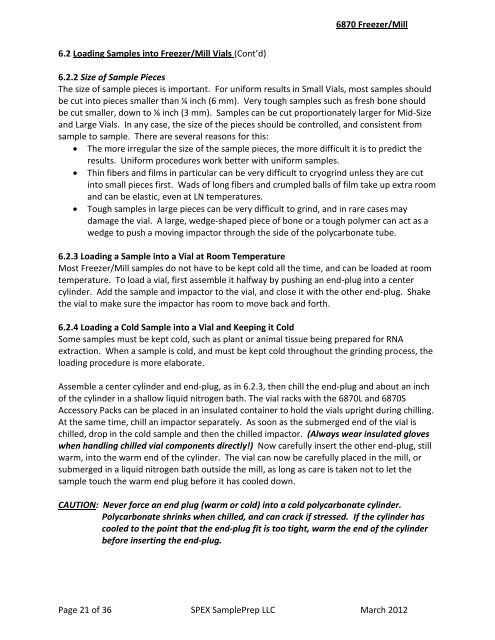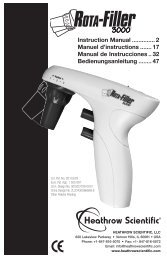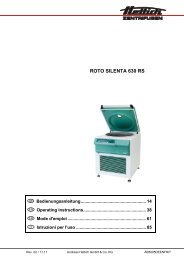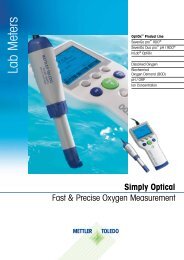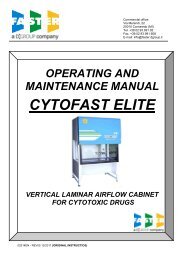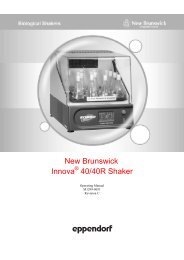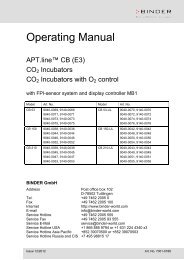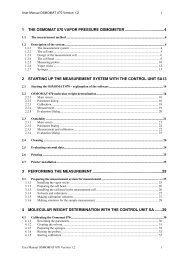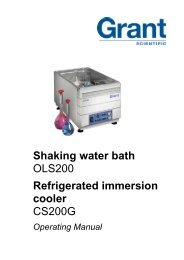#6750, FREEZER MILLS - Wolf Laboratories
#6750, FREEZER MILLS - Wolf Laboratories
#6750, FREEZER MILLS - Wolf Laboratories
Create successful ePaper yourself
Turn your PDF publications into a flip-book with our unique Google optimized e-Paper software.
6.2 Loading Samples into Freezer/Mill Vials (Cont’d)<br />
6870 Freezer/Mill<br />
6.2.2 Size of Sample Pieces<br />
The size of sample pieces is important. For uniform results in Small Vials, most samples should<br />
be cut into pieces smaller than ¼ inch (6 mm). Very tough samples such as fresh bone should<br />
be cut smaller, down to ⅛ inch (3 mm). Samples can be cut proportionately larger for Mid-Size<br />
and Large Vials. In any case, the size of the pieces should be controlled, and consistent from<br />
sample to sample. There are several reasons for this:<br />
The more irregular the size of the sample pieces, the more difficult it is to predict the<br />
results. Uniform procedures work better with uniform samples.<br />
Thin fibers and films in particular can be very difficult to cryogrind unless they are cut<br />
into small pieces first. Wads of long fibers and crumpled balls of film take up extra room<br />
and can be elastic, even at LN temperatures.<br />
Tough samples in large pieces can be very difficult to grind, and in rare cases may<br />
damage the vial. A large, wedge-shaped piece of bone or a tough polymer can act as a<br />
wedge to push a moving impactor through the side of the polycarbonate tube.<br />
6.2.3 Loading a Sample into a Vial at Room Temperature<br />
Most Freezer/Mill samples do not have to be kept cold all the time, and can be loaded at room<br />
temperature. To load a vial, first assemble it halfway by pushing an end-plug into a center<br />
cylinder. Add the sample and impactor to the vial, and close it with the other end-plug. Shake<br />
the vial to make sure the impactor has room to move back and forth.<br />
6.2.4 Loading a Cold Sample into a Vial and Keeping it Cold<br />
Some samples must be kept cold, such as plant or animal tissue being prepared for RNA<br />
extraction. When a sample is cold, and must be kept cold throughout the grinding process, the<br />
loading procedure is more elaborate.<br />
Assemble a center cylinder and end-plug, as in 6.2.3, then chill the end-plug and about an inch<br />
of the cylinder in a shallow liquid nitrogen bath. The vial racks with the 6870L and 6870S<br />
Accessory Packs can be placed in an insulated container to hold the vials upright during chilling.<br />
At the same time, chill an impactor separately. As soon as the submerged end of the vial is<br />
chilled, drop in the cold sample and then the chilled impactor. (Always wear insulated gloves<br />
when handling chilled vial components directly!) Now carefully insert the other end-plug, still<br />
warm, into the warm end of the cylinder. The vial can now be carefully placed in the mill, or<br />
submerged in a liquid nitrogen bath outside the mill, as long as care is taken not to let the<br />
sample touch the warm end plug before it has cooled down.<br />
CAUTION: Never force an end plug (warm or cold) into a cold polycarbonate cylinder.<br />
Polycarbonate shrinks when chilled, and can crack if stressed. If the cylinder has<br />
cooled to the point that the end-plug fit is too tight, warm the end of the cylinder<br />
before inserting the end-plug.<br />
Page 21 of 36 SPEX SamplePrep LLC March 2012


